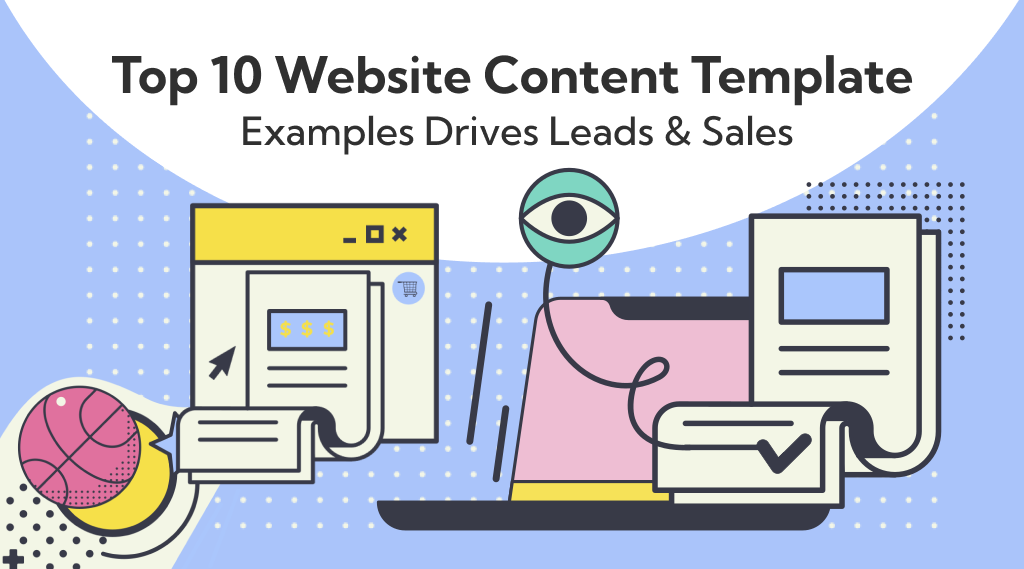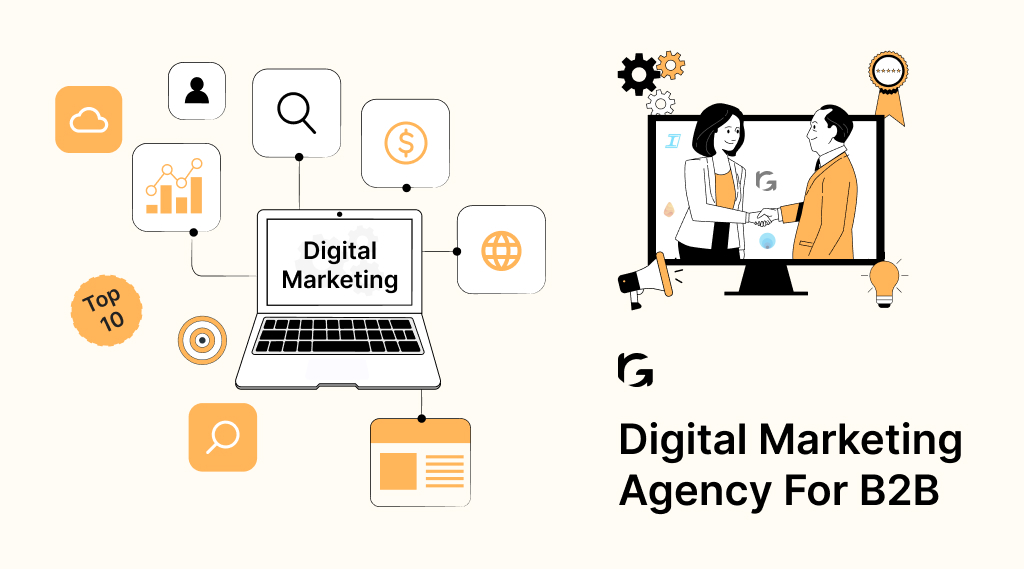Introduction
Creating compelling website content is essential for driving sales and engaging customers effectively. Whether you’re launching a new product, promoting a service, or simply looking to boost your online presence, having the right content templates can make all the difference. In this article, we’ll explore the top 10 website content template examples that are proven to drive sales and help you achieve your business goals. From engaging product descriptions to persuasive landing pages, these templates are designed to captivate your audience and convert visitors into loyal customers. Let’s dive in and discover how these templates can elevate your website’s performance and drive success for your business.
What is website content?
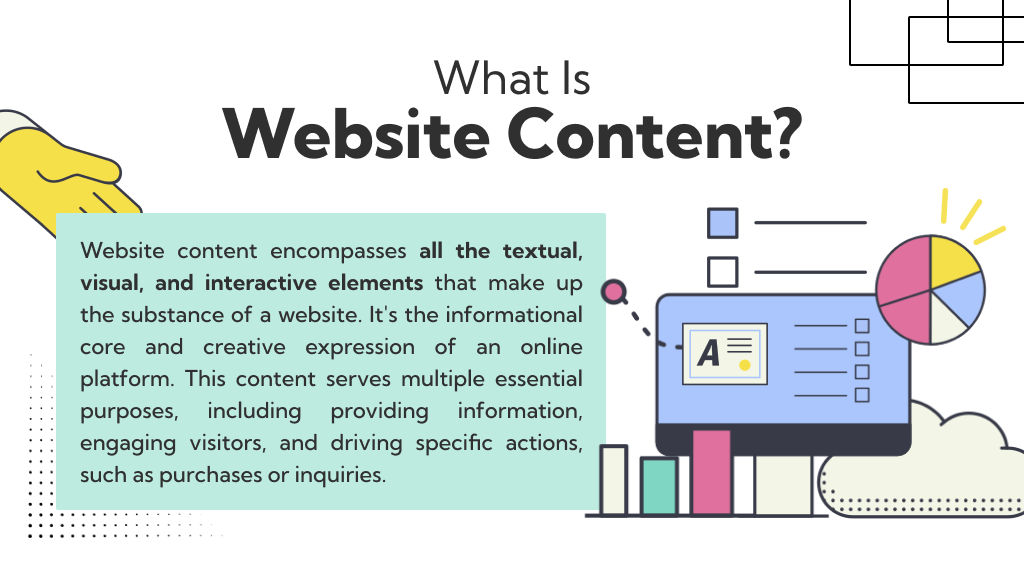
Website content encompasses all the textual, visual, and interactive elements that make up the substance of a website. It’s the informational core and creative expression of an online platform. This content serves multiple essential purposes, including providing information, engaging visitors, and driving specific actions, such as purchases or inquiries.
Textual content is perhaps the most fundamental component. It includes written information, such as articles, product descriptions, about pages, and contact details. The quality and relevance of textual content directly impact a website’s credibility, search engine visibility, and user engagement.
Visual content involves images, graphics, and videos, enhancing the aesthetic appeal and user experience. Well-chosen visuals can communicate messages effectively, evoke emotions, and leave a memorable impression on visitors.
Interactive content, like forms, quizzes, and clickable elements, encourages user engagement and interaction. It can be a vital tool for collecting user data, feedback, or guiding them through a specific user journey.
In essence, website content is the lifeblood of a site, serving as a bridge of communication between the site owner and its audience. Crafting compelling, informative, and user-friendly content is key to creating a successful website that accomplishes its intended goals, whether it’s to inform, entertain, sell, or engage.
How do you create content for a website?
Creating content for a website is a strategic process that involves several key steps. To ensure your website content is engaging, informative, and effective, follow these guidelines:
1. Define Your Audience: Understand your target audience’s preferences, needs, and pain points. Tailor your content to resonate with them.
2. Set Clear Goals: Determine the purpose of your website content. Is it to inform, entertain, sell, or engage? Having clear objectives will guide your content creation.
3. Keyword Research: Identify relevant keywords that your audience may use in search engines. Integrate these keywords naturally into your content for better search engine visibility.
4. Plan Structure: Organize your content with a clear hierarchy, using headings and subheadings to guide readers. This helps with readability and SEO.
5. Create Compelling Headlines: Craft attention-grabbing headlines that convey the essence of your content and encourage readers to continue.
6. Provide Value: Offer valuable information, insights, or solutions that address your audience’s needs. The more value you provide, the more trust you build.
7. Visual Elements: Incorporate images, videos, infographics, and other visual elements to enhance engagement and comprehension.
8. Edit and Proofread: Ensure your content is free of errors and is well-structured. Clear and concise writing is key to retaining your audience’s attention.
9. Optimize for SEO: Pay attention to on-page SEO, including meta tags, alt text for images, and internal linking to boost your website’s search engine rankings.
10. Regular Updates: Consistently update your content to reflect current information, trends, and audience interests.
By following these steps, you can create website content that not only attracts and retains visitors but also achieves your website’s objectives effectively.
The anatomy of a web page
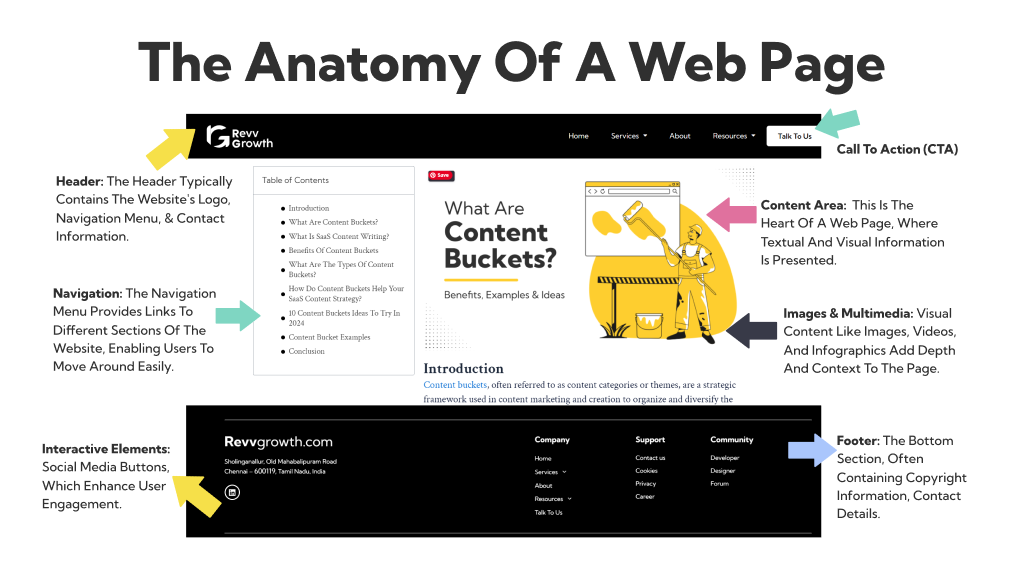
A web page is a complex and dynamic entity, composed of various essential elements that collectively contribute to its functionality and user experience. Understanding the anatomy of a web page is crucial for effective web design and development. Here’s a breakdown of its key components:
1. Header: The header typically contains the website’s logo, navigation menu, and contact information. It’s the topmost section of a web page, serving as a guide for users to explore the site.
2. Navigation: The navigation menu provides links to different sections of the website, enabling users to move around easily. It often appears at the top, side, or as a mobile-friendly hamburger menu.
3. Content Area: This is the heart of a web page, where textual and visual information is presented. It includes articles, images, videos, and other media elements.
4. Sidebar: Not all web pages have a sidebar, but it’s a common feature for displaying additional information, widgets, or links to related content.
5. Footer: The footer is the bottom section, often containing copyright information, contact details, and links to privacy policies or terms of use.
6. Call to Action (CTA): CTAs are strategically placed buttons or links that encourage users to take specific actions, such as signing up for a newsletter or making a purchase.
7. Interactive Elements: These include forms, search bars, comment sections, and social media sharing buttons, which enhance user engagement.
8. Images and Multimedia: Visual content like images, videos, and infographics add depth and context to the page.
9. Links: Hyperlinks connect web pages, allowing users to navigate between them.
10. Meta Information: Meta tags, including title tags and meta descriptions, impact how the page appears in search engine results.
Understanding the intricacies of a web page’s anatomy is crucial for web designers, developers, and content creators. Each component plays a unique role in shaping the user experience and achieving the website’s objectives.
What are the main elements of a website content?
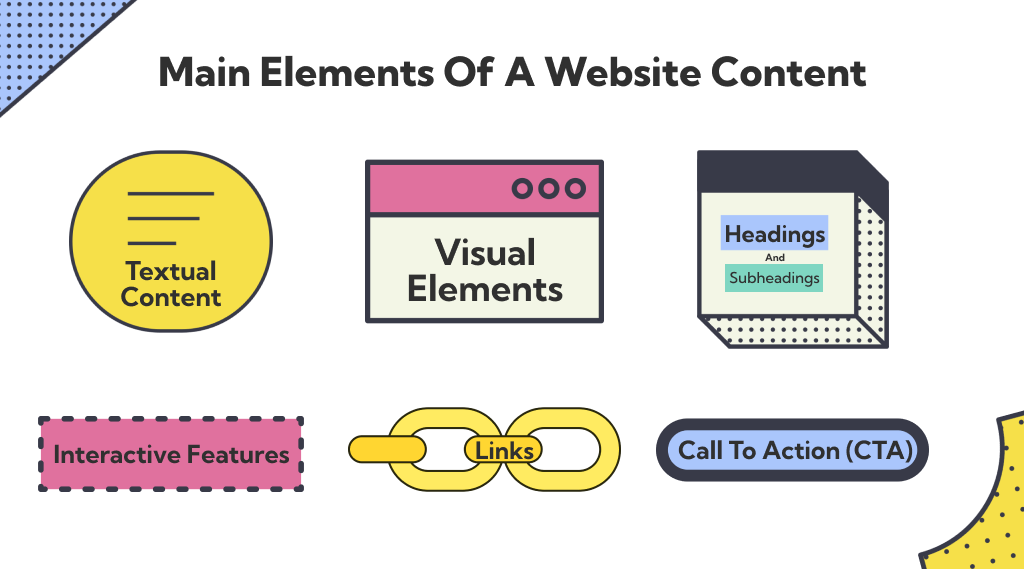
The main elements of website content are the building blocks that collectively shape the user experience and convey information effectively. These elements are pivotal for engaging visitors and driving desired actions. Here are the core components:
1. Textual Content: Written words form the backbone of website content, encompassing articles, blog posts, product descriptions, about pages, and more. Well-crafted text is vital for communicating information and building trust.
2. Visual Elements: Images, graphics, and videos enhance the visual appeal and storytelling potential of a website. They convey messages, evoke emotions, and improve user engagement.
3. Headings and Subheadings: A clear hierarchy of headings and subheadings organizes content, making it more scannable and easier to navigate. This aids in both user comprehension and search engine optimization.
4. Interactive Features: Forms, quizzes, surveys, and clickable elements encourage user participation and interaction. They can be used to collect data, obtain feedback, or guide visitors through specific user journeys.
5. Links: Hyperlinks connect different web pages, offering pathways for users to explore related content or external resources. They are essential for navigation and user guidance.
6. Call to Action (CTA): CTAs are strategically placed buttons or links that prompt users to take specific actions, such as signing up, subscribing, or making a purchase. They guide visitors toward conversion.
7. Meta Information: Title tags, meta descriptions, and alt text for images play a crucial role in search engine optimization (SEO). They impact how the website appears in search engine results and influence click-through rates.
Each of these elements plays a distinct role in creating a well-rounded and effective website content strategy. Balancing and optimizing them is key to providing an informative, engaging, and user-friendly experience to your audience.
What makes a good website content?

Good website content is the linchpin of a successful online presence, effectively communicating your message, engaging visitors, and driving desired actions. Here’s what makes website content stand out:
1. Relevance: Good content is highly relevant to the target audience. It addresses their needs, interests, and pain points, ensuring that visitors find value in what they read or view.
2. Clarity: It’s easy to read and understand. The language is clear, jargon is minimized, and complex concepts are explained concisely. Short paragraphs, bullet points, and headings improve readability.
3. Engagement: It captivates the audience through compelling storytelling, visuals, and interactive elements. It evokes emotions, piques curiosity, and encourages users to explore further.
4. Originality: Good content is unique, offering fresh perspectives, insights, or solutions. Plagiarism is avoided, and sources are properly credited.
5. Visual Appeal: It’s visually appealing with well-chosen images, graphics, and videos that enhance the content’s message. Proper formatting, fonts, and color schemes make the content visually inviting.
6. SEO Optimization: Content is optimized for search engines, using relevant keywords and meta tags. This improves visibility and helps users find your content through search.
7. Value-Driven: It provides value, whether it’s information, entertainment, or solving a problem. Valuable content builds trust and encourages repeat visits.
8. User-Friendly: The content is easily accessible on different devices and browsers. It loads quickly and is mobile-responsive.
9. Call to Action (CTA): Effective content includes clear and compelling CTAs that guide users towards desired actions, such as signing up, subscribing, or making a purchase.
10. Consistency: Content is regularly updated to reflect current information and maintain relevance.
A successful website strikes a balance between all these elements, creating content that not only informs but also engages and converts visitors into loyal customers or readers.
What is a website content template?
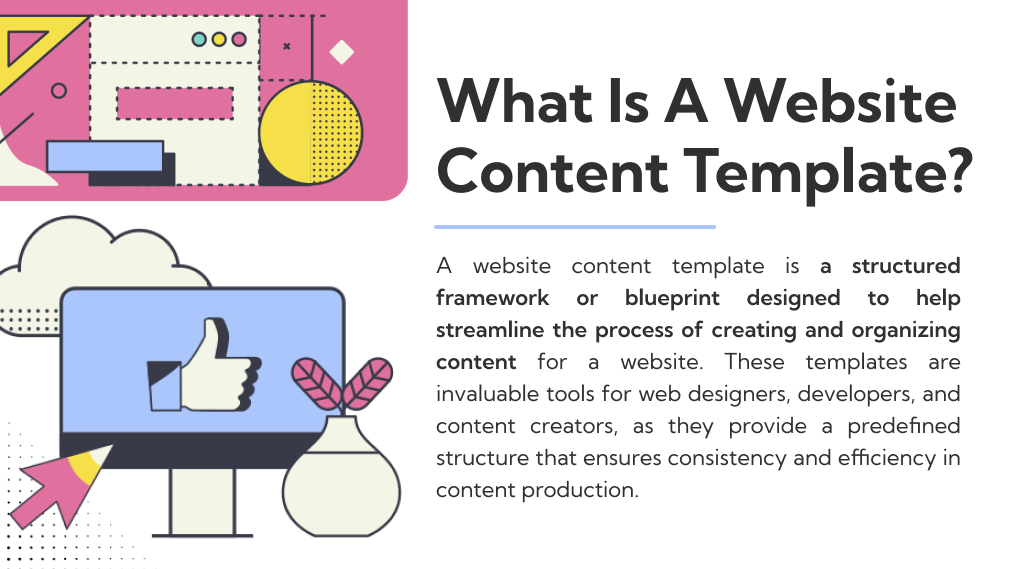
A website content template is a structured framework or blueprint designed to help streamline the process of creating and organizing content for a website. These templates are invaluable tools for web designers, developers, and content creators, as they provide a predefined structure that ensures consistency and efficiency in content production.
Typically, a website content template includes placeholders and guidelines for various elements of a webpage, such as headings, subheadings, body text, images, videos, call-to-action buttons, and more. These templates can be customized to match the specific needs and style of a website.
Website content templates offer several key advantages:
1. Consistency: They ensure that all web pages on a site have a uniform look and feel, enhancing the overall user experience.
2. Time-Saving: Content creators can save time by simply filling in the template with the necessary content, reducing the need to design each page from scratch.
3. User Experience: Templates help in organizing content in a way that enhances user navigation and readability.
4. SEO Optimization: By including fields for meta tags and keywords, templates support search engine optimization efforts.
5. Brand Consistency: They help maintain brand consistency by specifying fonts, colors, and styling.
Website content templates are flexible and adaptable, catering to various types of content, whether it’s for a blog, e-commerce site, portfolio, or informational platform. They serve as a valuable resource for achieving a cohesive, well-structured, and visually appealing website.
What are the types of website content templates?
Website content templates come in a variety of types, each tailored to specific types of web pages and content strategies. These templates serve as frameworks for content creation, ensuring consistency and efficiency in presenting information. Here are some additional types of website content templates:
1. Testimonial Page Templates: Testimonial pages are essential for building trust. These templates provide sections for customer or client testimonials, along with their names, photos, and endorsements. They help showcase social proof effectively.
2. FAQ Page Templates: FAQ pages answer common questions and address user concerns. These templates include questions and answers sections, enabling you to organize information for easy reference.
3. Event Page Templates: Event pages are essential for promoting and managing events. These templates offer fields for event details, schedules, location maps, registration links, and RSVP forms.
4. Resource Library Templates: A resource library template is ideal for organizing and presenting downloadable resources, such as e-books, whitepapers, or templates. It includes sections for resource descriptions, download links, and file previews.
5. Privacy Policy Page Templates: Privacy policies are a legal requirement for websites. These templates provide a structured format for explaining data handling, compliance, and user rights.
6. Terms of Service Page Templates: Similar to privacy policies, terms of service page templates help define the terms and conditions of using a website or service, offering a structured layout for legal information.
7. Video Gallery Templates: For websites with video content, video gallery templates include sections for video thumbnails, descriptions, and links. These templates provide an organized presentation of video content.
8. Membership Page Templates: Membership pages are crucial for subscription-based or exclusive content websites. These templates include fields for subscription plans, benefits, and registration forms.
9. Newsletter Signup Templates: Newsletter signup templates are designed to maximize email list growth. They offer form fields and compelling descriptions to encourage users to subscribe.
10. Press Release Templates: For businesses and organizations, press release templates ensure that news announcements follow a standardized format with sections for headlines, body content, contact information, and distribution details.
These additional website content template types cater to diverse website needs, from legal compliance to content presentation and user engagement. Each type streamlines content creation while maintaining a consistent style and structure.
Top 10 website content template examples to get inspired
Creating a compelling and functional website often starts with a well-structured content template. These templates provide a foundation for organizing information and enhancing user experience. Here, we’ll explore ten inspiring website content template examples that can serve as models for various types of web pages:
1. Blog Post Template: For bloggers and content creators, a blog post template is invaluable. It includes sections for a catchy headline, an engaging introduction, body text, images, bullet points, and a compelling call to action (CTA). A well-organized blog post template ensures consistency in content presentation and readability.
2. Landing Page Template: Landing pages are crucial for marketing campaigns. A well-designed landing page template has sections for attention-grabbing headlines, persuasive product or service descriptions, testimonials, and prominent CTAs. It’s essential for converting visitors into leads or customers.
3. E-commerce Product Description Template: E-commerce sites require consistency in presenting products. A product description template includes fields for titles, detailed product descriptions, pricing, images, and links to purchase. This ensures that each product page provides essential information in a structured manner.
4. About Us Page Template: For establishing your brand’s identity and story, an ‘About Us’ page template is vital. It should include sections for company history, mission, team bios, and values. Such templates help maintain a consistent and compelling narrative about your business.
5. Contact Page Template: The contact page is a crucial element for user engagement. It should include fields for contact information, maps, and contact forms. A well-structured contact page template makes it easy for visitors to get in touch with your business.
6. Portfolio Page Template: Designers, photographers, and creatives often rely on portfolio pages to showcase their work. A portfolio page template should have sections for project titles, descriptions, images, and links. It helps in presenting work in an organized and visually appealing manner.
7. Case Study Template: Case studies are essential for demonstrating success stories and the value you provide. A case study template includes sections for problem statements, solutions, and results, ensuring that each case study follows a consistent format.
8. Newsletter Template: Email newsletters are effective for staying in touch with your audience. A newsletter template should provide a design for headers, various content sections, and calls to action. It ensures that your newsletters are visually appealing and engaging.
9. Content Calendar Template: While not directly related to website content, a content calendar template is a planning tool for scheduling and managing content creation. It typically includes columns for content ideas, publication dates, and assigned authors. A well-organized content calendar is essential for content marketing strategies.
10. 404 Error Page Template: When visitors encounter a broken link, a custom 404 error page template can turn a frustrating experience into a positive one. It should include a user-friendly message, navigation options, and branding elements to maintain consistency.
These ten website content template examples offer inspiration for creating effective and visually appealing web pages. Utilizing these templates can save time and effort, ensuring that your website’s content is well-structured and engaging. Customizing these templates to match your brand’s style and objectives is essential for maximizing their effectiveness.
Conclusion
In conclusion, website content templates are indispensable tools for achieving consistency, clarity, and efficiency in the creation and presentation of web content. These templates offer a structured framework for a variety of web pages, ensuring that each page is both engaging and informative. Whether you’re a blogger, e-commerce entrepreneur, creative professional, or digital marketer, the right content template can serve as a guiding blueprint for creating content that resonates with your audience.
By utilizing the diverse range of templates we’ve explored, from blog posts and landing pages to product descriptions and error pages, you can streamline your content creation process while delivering a seamless user experience. These templates are not mere time-savers; they are enablers of effective communication, brand consistency, and optimized user engagement.
In today’s digital landscape, where websites serve as essential touchpoints between businesses and their audiences, having well-structured and visually appealing content is paramount. These top 10 website content template examples provide inspiration for building a strong online presence that captivates visitors and drives results. With the right templates and a touch of creativity, your website can become a powerful platform for conveying your message and achieving your objectives.
Stay tuned with revvgrowth.com, your one stop destination for everything SaaS.
